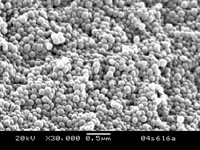Carbon Nanospheres from Sugar for Water Purification and Catalysis
(May 2005)

Colloidal nanoporous carbon spheres form from hydrothermal decomposition of glucose.
A simple modification to the ubiquitous process of making hard candy yields a remarkable phase of ultra-porous carbon with exceedingly high surface area. Chemically, sugar can be visualized as one-part carbon and one-part water. Remove the water and carbon remains, as anyone who has burned candy on the kitchen stove is keenly aware. The decomposition process can be retarded through moderate heating (150°C for 48 hours) of an aqueous sugar solution in a pressurized vessel. Under these conditions, the sugar molecules gradually polymerize and subsequently decompose to form chains of carbon atoms through release of water to the aqueous solution. Attractive forces between the chains and repulsive forces with solution molecules then cause the chains to self-assemble into homogeneous, nano-porous spheres of carbon that segregate from the solution. Sphere size is controlled by sugar concentration and processing conditions. The chemically robust and high surface-area form of carbon that results is particularly well suited to sequester pollutants from contaminated water streams, remove airborne contaminants, or serve as catalyst supports for promoting industrially-important processes including production of chemicals and refining of oil.
